In the last decade, child labour has decreased by 38%; however, 152 million children are still affected and the COVID-19 pandemic has exacerbated the situation. Child labour reaches many different corners across the world, often occurring in various sectors that can have detrimental educational, health and psychological impacts on children’s well-being. There are various drivers of child labour such as poverty, armed conflict, inadequate laws and regulations, social inequality, discrimination and ingrained cultural traditions to name a few.
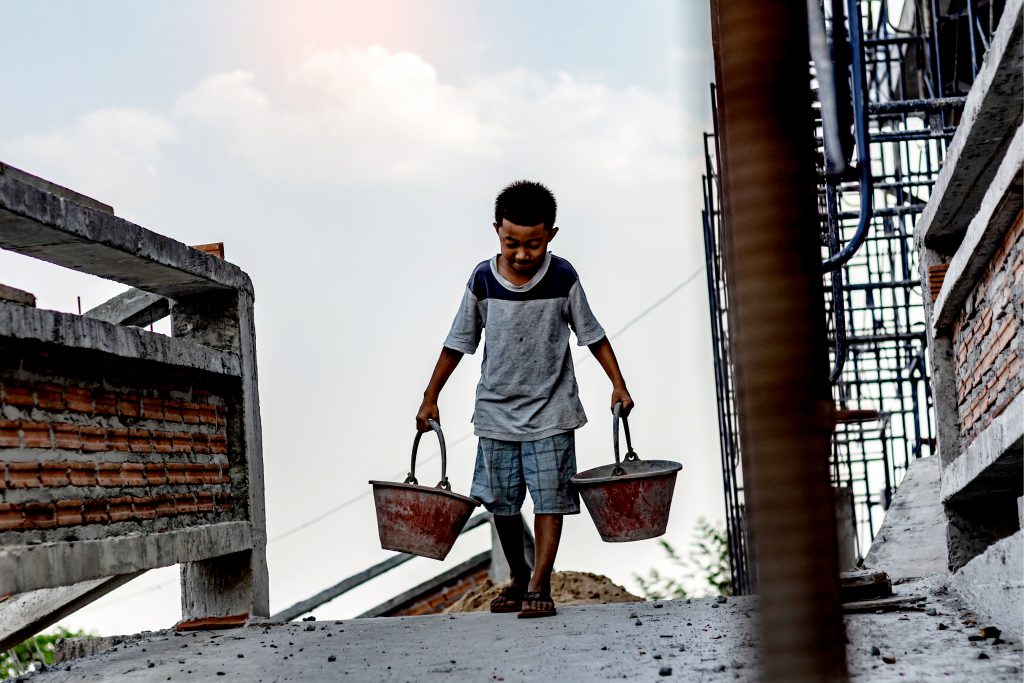
Defining child labour
The International Labour Organization (ILO) defines child labour as “work that is mentally, physically, socially or morally dangerous and harmful to children; and/or interferes with their schooling by: depriving them of the opportunity to attend school; obliging them to leave school prematurely; or requiring them to attempt to combine school attendance with excessively long and heavy work” (ILO, n.d).
Not all forms of work undertaken by children are considered to be child labour. This varies from country to country and depends on the child’s age, the type of work performed, the number of hours put into work, the conditions they work under and whether it interferes with their schooling. There are activities that children can engage in – such as helping their family in the house, or assisting in a family business to earn an allowance during the school holidays – that can be positive for their development and provide children with skills and experience in order to prepare them for adulthood (ILO).
Defining the ´worst forms of child labour´
Under Article 3 of ILO Convention No. 182, the worst forms of child labour are defined as (ILO, 1999):
- all forms of slavery or practices similar to slavery, such as the sale and trafficking of children, debt bondage and serfdom and forced or compulsory labour, including forced or compulsory recruitment of children for use in armed conflict;
- the use, procuring or offering of a child for prostitution, for the production of pornography or for pornographic performances;
- the use, procuring or offering of a child for illicit activities, in particular for the production and trafficking of drugs as defined in the relevant international treaties;
- work which, by its nature or the circumstances in which it is carried out, is likely to harm the health, safety or morals of children.
The worst forms of child labour include (ILO):
- Child trafficking
- Sexual exploitation (which includes pornography and prostitution)
- Drug trafficking
- Debt bondage (also referred to as bonded labour)
- Slavery
- Forced labour
- Organized child begging
Defining ´hazardous child labour´
Hazardous child labour is defined under Article 3(d) of ILO Convention No. 182 as “work which, by its nature or the circumstances in which it is carried out, is likely to harm the health, safety or morals of children” (ILO). Child labour is considered hazardous when a child is working in an unhealthy or dangerous environment where they are at risk of falling ill, psychological and physical injury and in some cases, death (ILO).
Hazardous child labour is the largest category of child labour; it is estimated that approximately 73 million children are working in dangerous environments which include the mining, agriculture, manufacturing and construction sector, including work undertaken in bars, nightclubs, restaurants, markets and domestic services. Hazardous working conditions can cause lifelong illnesses that may not develop until later into adulthood (ILO).
Defining ´forced´ child labour
Under international law, ´forced´ labour is defined as “work or service which is exacted from any person under the menace of any penalty for its non-performance and for which the worker does not offer himself voluntarily” (Thevenon & Edmonds, 2019).
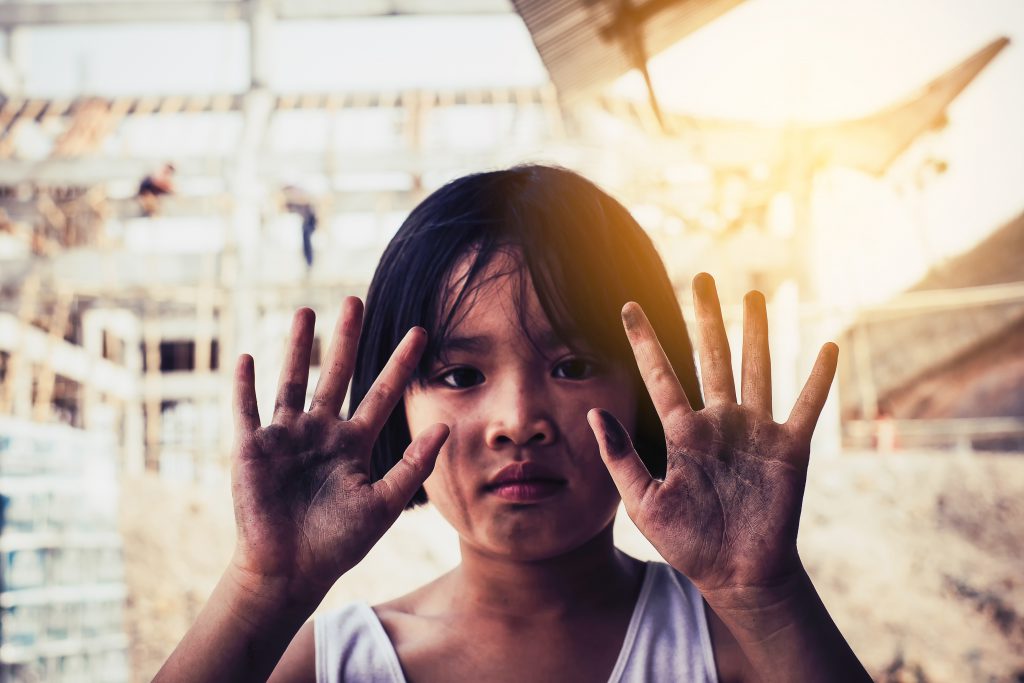
This can take two forms: (1) children are forced into labour by their parents/caregivers and their parents are aware of their working conditions; (2) children are forced into labour as a result of trafficking, coercion or deceptive recruitment. In relation to the latter category, these children may have migrated alone or were victims of human trafficking, leaving their parents unaware of their working conditions (Thevenon & Edmonds, 2019).
There are three main categories of forced labour (Thevenon & Edmonds, 2019):
- Exploitation – which includes slavery, slavery-like practices, forced domestic labour and bonded labour.
- Commercial sexual exploitation
- State-imposed forced labour
Global estimates of child labour
The global estimates of child labour as reported by the ILO at the beginning of 2020 were 160 million children – 97 million boys and 63 million girls engaged in child labour. Out of the 160 million children, 79 million children were engaged in hazardous work (ILO, 2020).
According to an ILO report from 2019, approximately 9 in 10 children living in Africa, Asia and the Pacific are involved in child labour. Africa is the highest rank continent, where 1 in 5 children are involved in child labour (Thevenon & Edmonds, 2019).
Globally, child labour progress remains uneven. Across Africa, 72 million children are engaged in child labour and 62 million across Asia and the Pacific. 70% of children engaged in child labour globally work in the agricultural sector, predominantly in livestock herding and subsistence and commercial farming (ILO, 2021).
Drivers of child labour
Despite laws and regulations protecting children from child labour, it still exists. Globally, there are numerous reasons children are pushed into work, with poverty being the greatest driving force. The main causes of child labour include:
1. Poverty and unemployment
Children need to support their families and their survival is dependent on them working. This vulnerability is taken advantage of by criminal gangs or traffickers.
2. Inadequate or weak national educational systems
Inadequate or weak national educational systems play a significant role in child labour. Communities that have inadequate educational facilities, including a lack of teachers and resources, create an unstable environment in which children do not have access education, which in turn pushes them towards child labour. Some families are unable to afford school fees, pushing them towards child labour as a more lucrative use of children’s time. Some cultures place less emphasis on girls going to school and prefer that girls are prepared to carry out household tasks (ILO).
3. Ingrained cultural traditions and attitudes surrounding child labour
Various cultural norms and traditions around the world tacitly encourage child labour by promoting the importance of work to a child’s development. For example, certain cultures believe that working is important for character and skill development, regardless of the effects this might have on a child’s realization of their human rights. Children are expected to follow in their parents’ footsteps and learn a particular trade in order to support their families.
Other traditions encourage children to work to pay off debts borne from social occasions and religious events. These widespread and varied manifestations of bonded labour take advantage of children’s vulnerable position within wider societies and cultural expectations. In this way, children are often framed as family supporters, rather than dependents.
4. Violation of existing laws and regulations on child labour
5. Inadequate enforcement of laws and regulations
6. Civil or political unrest or natural disasters
Child labour in different sectors
Child labour is prevalent in various sectors including:
1. Agriculture sector
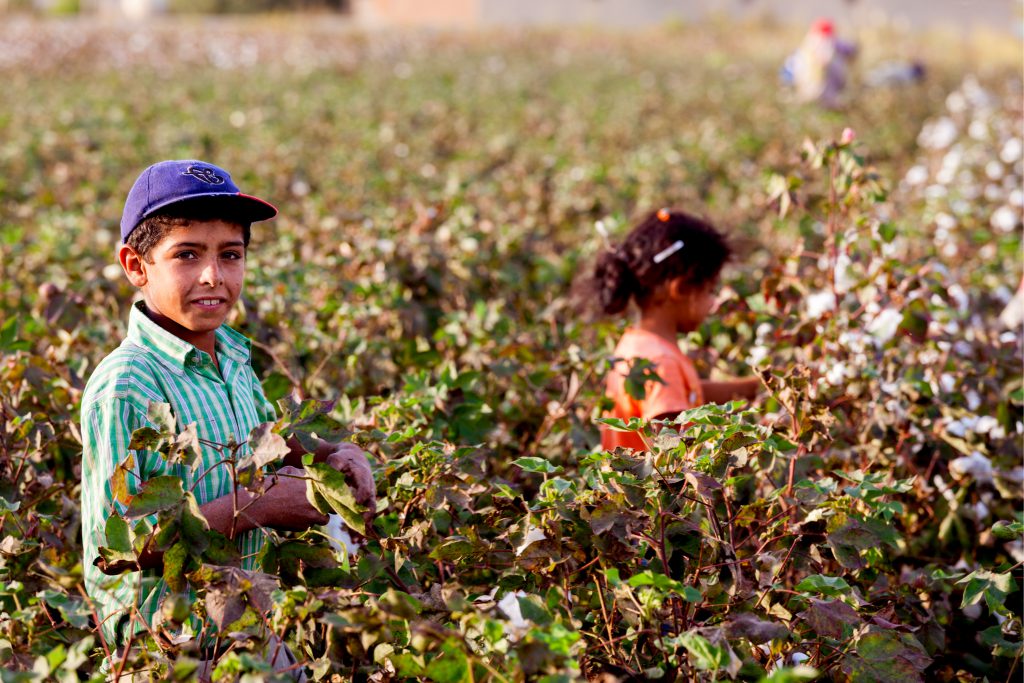
Traditional societal attitudes towards children’s participation in agriculture, lack of agricultural technology, the high costs of adult labour and poverty are some of the main drivers of child labour in the agriculture sector. This sector is one of the most dangerous for children in terms of occupational diseases, non-fatal accidents and work-related fatalities (ILO). Not all child participation in the agricultural activity is considered child labour. Tasks which are low-risk, age-appropriate and do not interfere with a child’s time (education or leisure) fail to meet the child labour threshold. These activities must be non-hazardous and can often benefit families and communities by providing children with vital social and technical skills as well as enhancing local food security (ILO).
The sub-sectors that exist within the agriculture industry include (ILO):
- Fishing
- Livestock production
- Farming
- Forestry
2. Domestic work also referred to as household work
Domestic work can be defined as instances in which a child under the age of 18 years works within the home of their employer to carry out household chores. Whilst the cultural norm is for girls to work inside the house, boys are more likely to work outside the house (i.e. looking after livestock or gardening). Child domestic workers sometimes live in the home of their employers and may or may not get paid for their work (Thevenon & Edmonds, 2019).
3. Factory work, predominantly in the garment and textile sector
In countries such as Zimbabwe, Indonesia, India, Argentina, Brazil and Malawi, factory child labour is prevalent within the tobacco industries (World Vision). More commonly, child labour in factories often relates to the garment industry and is especially prevalent in Asian countries such as Cambodia and Bangladesh. The rise in fast fashion has pushed companies to find cheaper sources of labour, children. Children work at all stages of the supply-chain production from cotton picking, harvesting, yarn spinning and factory work. This is prevalent in countries such as Egypt, Pakistan, China, Thailand, India, Bangladesh and Uzbekistan (Moulds).
4. Industry and manufacturing (which includes working in mining, quarrying and construction)
Child labour in mines and quarries is prevalent in countries such as Mali, Burkina Faso, Ghana, Niger, Democratic Republic of Congo, Nigeria, Sierra Leone, Liberia, Zambia and Zimbabwe (Child Labour Platform & ILO, 2019).
The sub-sectors that exist within the mining industry include (ILO):
- Gold mining
- Salt mining
- Stone quarrying
- Artisanal mining
Effects of child labour
Child labour can have a range of both mental and physical health effects on a child that often continue into adulthood, these vary and include long-term health issues due to abuse, injuries, malnutrition, exhaustion, psychological harm or exposure to chemicals, among others. The mental and physical effects vary depending on the sector that children are working in (Dubay, 2021).
- In agriculture, children are often exposed to working with hazardous toxic fertilizers and pesticides, as well as heavy and dangerous tools or blades (Dubay, 2021).
- In domestic work, children face the risk of being abused by their employers, working excessively long hours or being isolated from their friends and family (Dubay, 2021).
- In construction, children face the risk of injury from working with dangerous and heavy loads and lack adequate personal protective equipment (Dubay, 2021).
- In mining, children are exposed to working with explosives, poisonous chemicals and face the risk of being placed in dangerous environments such as mines which are regularly the source of collapses that can lead to serious injury or death (Dubay, 2021).
- In manufacturing, children are exposed to unhealthy toxins, hazardous chemicals and poor health and safety working regulations (Dubay, 2021).
Child labour and gender inequality
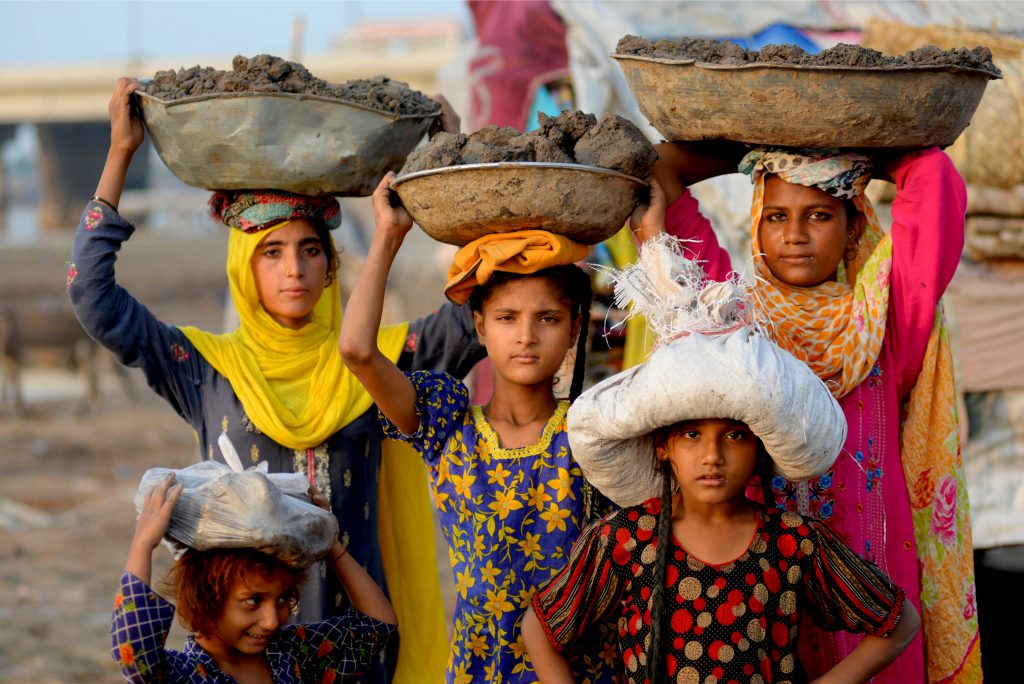
The involvement of boys in child labour is much higher than girls, with approximately 11.2% boys in child labour compared to 7.8% of girls. According to the most recent ILO-UNICEF 2020 report on child labour, it is estimated that there 89.3 million children engaged in child labour between the ages of 5 – 11 years old, 35.6 million between the ages of 12 – 14 and 35 million between the ages of 15 – 17 years (ILO, 2020). This gender gap increases with age as girls are more likely to be involved in unpaid and under-reported domestic child labour. In countries such as Congo, Yemen, Nepal, Peru, Mozambique, Chad and Somalia more girls are involved in child labour than boys (Thevenon & Edmonds, 2019).
It is worth noting that statistics estimating the prevalence of girls and boys in child labour across the globe are subject to a few limitations. Primarily, reliable data sources on child participation in work are limited. Further, the definition upon which these estimates are typically based does not include work within children’s homes, despite the fact that girls shoulder a disproportionate burden of household labour in many societies. Recent research by the ILO attempting to include this overlooked portion of child labour purports that involvement in household chores for more than 21 hours a week is considered child labour. Once this fact is taken into account, the global gender gap in child labour prevalence is reduced by almost half (ILO).
Child labour in urban and rural settings
It is more common for child labour to occur in rural areas. According to an ILO study in 2020, 122.7 million rural children were involved in child labour and 37.3 million urban children (ILO, 2020). The most common type of child labour is family-based and this accounts for 72% of all child labour. Family-based child labour is often considered hazardous with 1 in 4 children between the ages of 5-11 years engaged in work that is likely to cause harm to their health (ILO, 2020).
Child labour and education
Poverty, being the main driver of child labour, pushes children into work which forces them to leave school early. Globally, one-third of children engaged in child labour are excluded from school and there is a strong correlation between a child’s participation in hazardous work and low school attendance (ILO, 2020).
There are several reasons why child labour affects children’s education. For example, the work may be very demanding, they are unable to access education or free schooling, an alternative does not exist or their families push them to work as in certain cultures family perceptions around work and gaining money are more important than education (ILO, 2020).
Globally, as of 2020, the percentage of children between the ages of 5 – 14 years that do not attend school include: 15.5% in Latin America and the Caribbean, 28.1% in Northern Africa and Western Asia, 28.1% Sub-Saharan Africa, 35.3% in Central and Southern Asia and 37.2% in Eastern and South-Eastern Asia (ILO, 2020).
Child labour and migration
Child migration, often accompanied by family members, can lead to new child labour vulnerabilities. One of the most common drivers of child migration is the availability of seasonal work opportunities in agriculture and brick kilns for parents. Unfortunately, children frequently accompany their parents to support their work and increase the household income as for many migrant working families, this extra output is essential (van de Glind, 2010).
Child labour and COVID-19
In the last two decades, significant improvements have been made in the fight to end child labour. However, the COVID-19 pandemic has threatened to undermine these developments and could potentially reverse many years of progress to eradicate child labour. Prior to the pandemic, the amount of children involved had increased by 8.9 million in just four years. This increase is attributed to rising global poverty levels and is expected to continue into 2022 (ILO, 2020).
Due to an increase in unemployment since the pandemic, families are more inclined to push their children into child labour as a coping mechanism. This is further exacerbated by school closures which leave children vulnerable and at a greater risk of child labour. Non-governmental organisations working within the African region have noted that school closures have pushed children into work as they are expected to help look after their families (ILO, 2020).
Eliminating and preventing child labour
In 2019, the International Labour Organization (ILO) in partnership with Alliance 8.7 launched the International Year for the Elimination of Child Labour for 2021. The aim of 2021 is to urge governments to encourage legislative and practical actions towards the eradication of child labour and to achieve Target 8.7 of the United Nations Sustainable Development Goals (ILO, 2021).
Although global progress has been made towards reducing child labour, the lofty target of eliminating the practice by 2025 remains unmet. The response to this persistent challenge must be unified, intersectional and backed by actionable legislation. In particular, minimum working age requirements and their enforcement are a fundamental component of child labour responses.
Beyond legal and regulatory frameworks, governments and civil society must work to design and implement policies which provide families and children with alternative livelihoods, steering them away from the trappings of child labour. These initiatives must ensure that children are at the heart of all decision-making processes, and that any useful interventions are accessible to the children themselves (Thevenon & Edmonds, 2019).
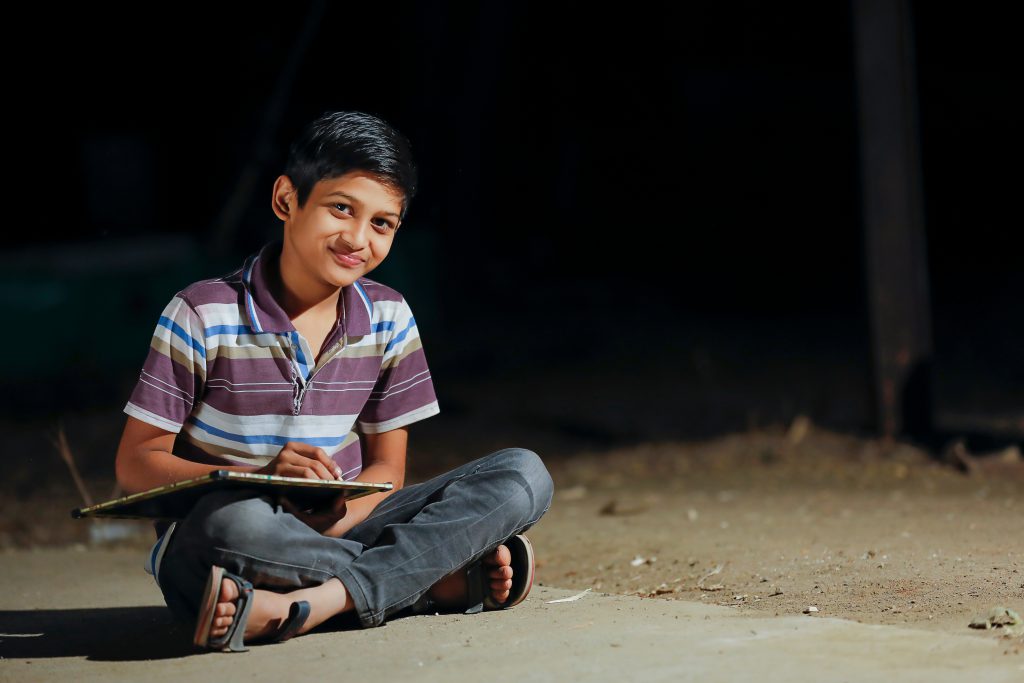
To upscale the fight against child labour, greater research and public awareness campaigns are required. Governments around the world must acknowledge the scale of this challenge, its evolution and the ways in which families and children are hampered by its presence (Thevenon & Edmonds, 2019). Summarily, governments should work to ensure (Thevenon & Edmonds, 2019):
- The existence of minimum working age legislation and their enforcement
- The development of tools and mechanisms to monitor child labour
- Functional public awareness raising campaigns
- Support to community-led initiatives
- Greater protection for vulnerable children and families
- Affordable, fair, quality and accessible education for all
- The promotion of positive cultural and societal norms against child labour
Key documents and international legal instruments
There are various international legal instruments that recognize and respond to child labour. In particular:
- United Nations Convention on the Rights of the Child
- The African Charter on the Rights and Welfare of the Child
- ILO Convention No. 138 (on minimum age for admission to employment) (1973) Recommendation No. 146
- ILO Convention No. 182 (concerning the prohibition and immediate action for the elimination of the worst forms of child labor) (1999) Recommendation No. 190
- ILO Convention No. 189 (concerning decent work for domestic workers) (2011) Recommendation No. 201
- United Nations optional protocol on the sale of children, child prostitution and child pornography (2000)
- United Nations optional protocol on the involvement of children in armed conflict (2000)
- United Nations resolution ¨A world fit for children¨ A/RES/S-27/2
Written by Vanessa Cezarita Cordeiro
Last updated on 31 August 2021
For more information:
International Year for the Elimination of Child Labour
World Day Against Child Labour 12 June
References:
Council of Europe. (2013, August 20). “Child labour in Europe: a persisting challenge.”
GPE Secretariat. (2016, June 12). “Child labour hinders children’s education.”
Human Rights Watch. (2021, May 26). “COVID-19 pandemic fueling child labour.”
International Labour Organization, Worst Forms of Child Labour Convention, C182, 17 June 1999.
International Labour Organization. ¨Causes¨.
International Labour Organization. ¨Hazardous child labour¨.
International Labour Organization. ¨The worst forms of child labour¨.
International Labour Organization. ¨What is child labour¨.
International Labour Organization. “Child labour in Africa.”
International Labour Organization. “Child labour in agriculture”.
Moulds, J. “Child labour in the fashion supply chain.”
UNICEF., & ILO. (2020). ¨COVID-19 and child labour: A time of crisis, a time to act.¨
UNICEF. (2021, June 9). “Child labour rises to 160 million – first increase in two decades.”

